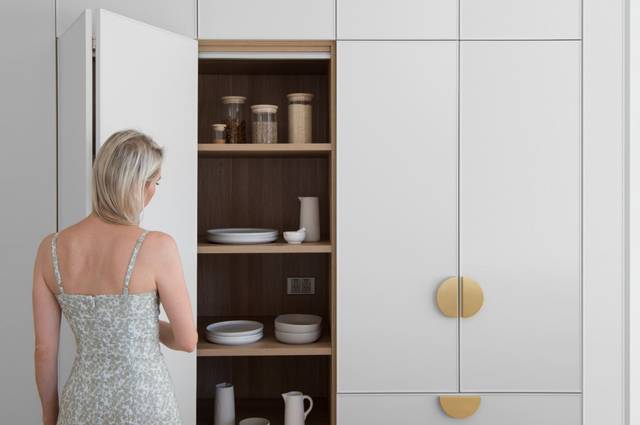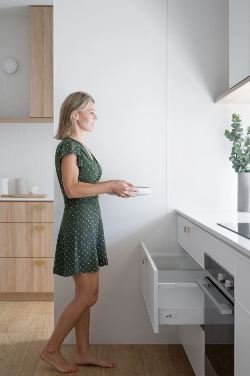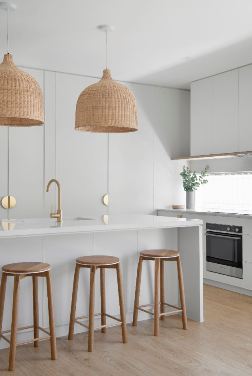Here are six top kitchen layouts (and some tips to get the best out of them)

If you’re planning to renovate your kitchen, don’t just jump in with both feet. With a completely blank canvas, this is your chance to reinvent your space so you and your family can get the most out of your new home hub for years to come. Yes, a kitchen can be so much more than a place for cooking – with a little thought.
The point is, while you’ll want to make sure your kitchen is a comfortable and functional place to prepare food, you should also maximise the area as a place to socialise or even eat. But the shape and amount of space you’ve got to play with is usually an incredibly important factor in how you decide to do it.
So, to help you design the right kitchen for your home, here are six popular layouts with our insights on where they should be used and what features really make them work.
Horseshoe shaped kitchens
A horseshoe shaped kitchen is best suited to medium to large family homes. They’re typically used in spaces where there is enough room for something bigger than a galley style kitchen, but not so big that distances between benchtop areas and storage becomes inconvenient.
Another benefit of the horseshoe layout is that it maximises the amount of worksurface you have – which is great if you’ve got multiple cooks all under one roof. Meanwhile, this floor plan will also allow you to incorporate a central dining table or even a mobile island, while it’s also great for open plan layouts which connect the kitchen to living spaces.
With the benefit of so much wall and floor space, you have free reign to design your horseshoe kitchen intelligently by grouping functional areas. Some examples might include pull-out waste bins and cleaning storage under the sink in one area, while all your pots and pans are conveniently stored under and around your cooktop and oven.
Galley Kitchens
Well suited to apartments and older houses where open space is often limited, the galley layout ensures maximum use of wall space while maintaining plenty of floor space in between to manoeuvre. Better still, if you have a taller ceiling height, you can get even more out of your wall space by installing full height cupboards with pull-out drawers for food storage, so everything is easily visible.
The truth is smaller galley style kitchens can still feel open and uncluttered provided you think smartly about some of the less obvious features. For example, choosing sliding doors instead of hinges can prevent cabinetry doors from obstructing the floor space, while deep drawers for pots and pans and drawer organiser solutions can be a real space saver.

Island kitchen
If you’ve got dreams of using your kitchen as a place to socialise and entertain friends, the island style floor plan gives you a place for people to gather without getting in the way of your surrounding kitchen space and features. Islands also offer a large additional preparation area, while the extra space created underneath could be ideal for storing heavier items in deep, smooth sliding pull-out drawers.
Alternatively, an island could even be used as a station for appliances or your sink which means your surrounding worksurfaces, storage and fridge will always be in easy reach. Islands are also a great way to create a more open plan look and feel as people can move freely around.

L-shaped kitchen
Popular for medium to large homes with ample wall space, L-shaped kitchens are ideal for creating a sense of space with an open plan look – particularly if you’re aiming to incorporate garden or patio access into your design. The L-shaped design is also ideal if you want to include a dining table but don’t have the space to fit one into a U-shaped kitchen layout.
To make an L-shaped kitchen as functional as possible, position tall features such as a wall oven, fridge and pantry on one side while leaving the other free for your preparation area, cook top and sink. Not only will this make the aesthetic design of your kitchen flow better, but you’ll also have maximum workspace with functional areas and fittings intelligently placed to limit your moving around.
One corner/straight-line kitchen
As the name suggests, one corner kitchens are the best approach to compact spaces such as small apartments and studios without a separated or closed kitchen. If applied to larger spaces, the straight-line kitchen can start to create impractical distances between different functional areas of the kitchen while the overall look is much less intimate.
Working with one wall, it’s important to make sure your straight-line kitchen looks visually balanced with taller units such as the fridge, pantry, and wall oven at either end. This also creates a cosy nook for your preparation area, sink and stove top which are all conveniently within easy reach. Meanwhile, the in between wall space can be used to maximise storage and make your space more ergonomic with wall shelving, or cabinetry with sliding doors, bi-folding doors or lift up doors with hydraulic hinges.
G-shaped kitchen
If you don’t have quite enough space for a standalone island work surface in your new kitchen, then a G-shaped layout could be the perfect solution. Essentially, it’s a horseshoe shaped layout where one worksurface doesn’t have a wall behind it, creating a semi-island that’s connected to the rest of your workspace. This is sometimes also known as a peninsula kitchen.
The ‘peninsula’ of a G-shaped kitchen can also bring multiple functions, making them ideal for smaller areas where space limitations won’t allow for extra features. For example, the peninsula offers extra working space, a place for additional storage, and even seating on one side.
But it’s important to make sure your G-shaped kitchen is intelligently designed, because without as much wall space as other layouts, you could find yourself bending down a lot for utensils and other items. So, as an alternative to cupboards, consider installing deep pull-out drawers below your benches to make easy work of retrieving heavy pots and pans.



